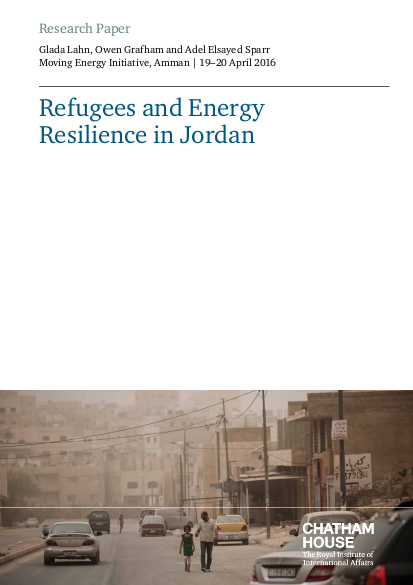
The Syrian refugee crisis is increasing energy and water stresses in neighbouring countries like Jordan. International aid flows offer an opportunity to build long-term resilience to shortages.
- Jordan has welcomed hundreds of thousands of refugees since it gained independence in 1946, with the majority of them successfully integrating into the country’s vibrant, peaceful society.
- The latest and largest population increase of over 700,000 resulting from the Syrian crisis since 2011 - entailing increases of 30 percent in some cities – has added to pressures on public services and already strained water and energy resources.
- Fuel, power and water use have risen sharply since 2011, as have subsidy bills for the government. Low- to middle-income Jordanians feel the pressure from inflation, a housing shortage and unemployment, all of which are perceived to be exacerbated by Syrian and Iraqi refugees and the influx of foreign aid agencies. Meanwhile, the majority of refugees are living below the country’s poverty line, with households spending a high proportion of meagre and dwindling incomes on energy and water.
- Jordan is exceptional in having national response and resilience plans aimed at channelling aid and financing to enable it to manage these pressures as well as improve the lives of both refugees and Jordanians. This is a new approach with relevance to other countries facing similar circumstances and there are now several projects straddling humanitarian and longer term development agendas through investments such as solar plants serving both refugee camps and local villages and solar panels to reduce increased energy bills for schools.
- In a situation like Jordan’s, the energy and water challenges facing refugees cannot be separated from wider national needs.
- Humanitarian agencies may not be the best equipped to initiate or manage new energy/water projects. The best role for these organizations may be to support opportunities for growing the local clean energy market.
- Aid pledges from donors and FDI could achieve multiple benefits through funding infrastructure projects and strategic sectors identified in the Jordan Response Plan (JRP), including water, energy efficiency, renewable energy and green construction; additional funding is needed to find practical financing models for increased uptake of efficiency services and technology, and helping to build government capacity in areas such as building code enforcement and sustainable urban planning.
- For effective implementation, several high level policy developments are needed, including upgrading the grid to enable more renewable energy uptake; clear, sustainable policies on tariffs and finding ways for users (both low-income Jordanians and refugees) to pay for the energy or efficiency services from which they benefit. For refugees, this means finding ways of allowing them to work legally.
